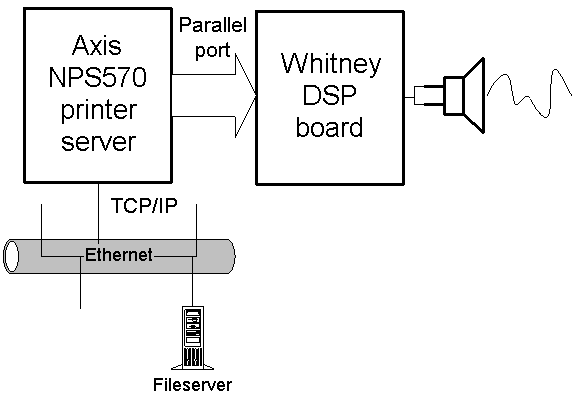 A DSP-based decompressor
unit for high-fidelity MPEG-Audio over TCP/IP networks
A DSP-based decompressor
unit for high-fidelity MPEG-Audio over TCP/IP networks A DSP-based decompressor
unit for high-fidelity MPEG-Audio over TCP/IP networks
A DSP-based decompressor
unit for high-fidelity MPEG-Audio over TCP/IP networks[ Home | Contents | Component and tool archive ]
Previous chapter: Design of the DSP hardware, next chapter: Conclusion
One of the goals with the thesis was that the unit should be able to accept a compressed audio stream over a computer network, using the TCP/IP protocol suite that Internet is based on. Conveniently, the Axis NPS570 Printerserver bridges the gap between TCP/IP on a local network and the parallel port that is required to feed an audio stream into the DSP board, and the NPS570 was hence used as the network interface for the DSP board, using a short parallel cable between the two devices.

A fileserver also connected to the ethernet using the TCP/IP protocols, was used as the source of compressed MPEG-audio streams. The fileserver could be used to initiate a File Transfer Protocol (FTP) session to the printerserver, sending any file which the printerserver would output to the DSP board through the parallel port. The first stream sent to the DSP board would be the DSP code itself, but after that is sent, any MPEG-audio stream could be sent for decoding.
The playback is not limited to a local ethernet - the fileserver pushing the audio stream could as well be located on the Internet far away, the only restriction is that the average speed needs to be more than the MPEG-stream bitspeed. The printerserver used has some memory (512kbytes or less free) which it will fill up for buffering the stream, and the DSP board has a one-second buffer as well, so the system as a whole is immune to short (a couple of seconds at a time) network blockings.
Previous chapter: Design of the DSP hardware, next chapter: Conclusion
This document may be freely distributed for educational purposes. See the copyright notice for additional information.